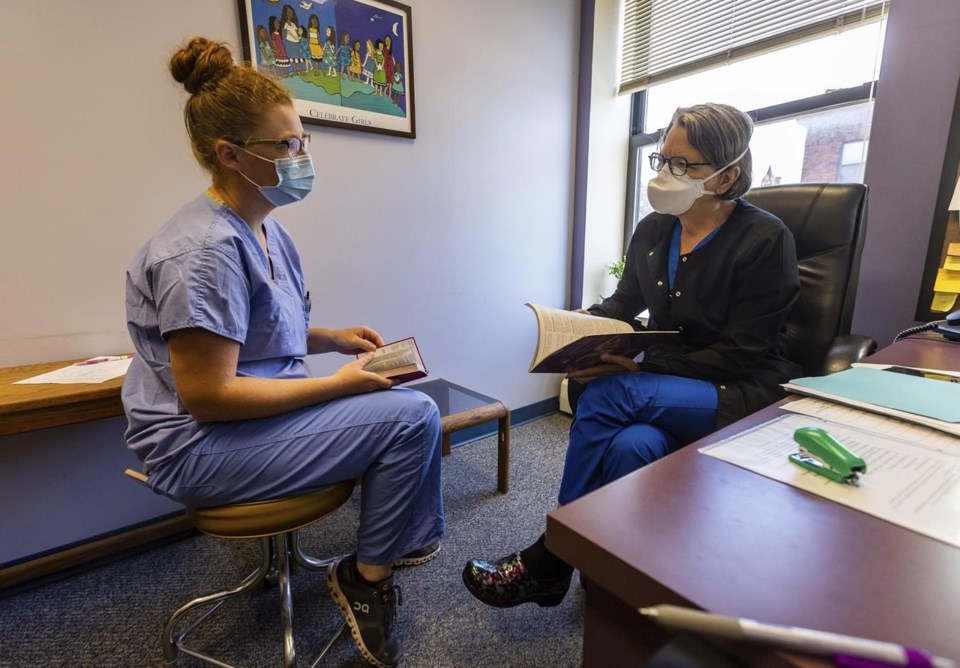DULUTH, Minn. (AP) — On the top floor of a modest two-story brick building near the shore of Lake Superior, the executive director of northern Minnesota's only abortion clinic flits from room to room, checking in patients, fielding phone calls from people seeking appointments and handling billing questions from those struggling to pay.
In the waiting room at WE Health Clinic in Duluth, patients from Wisconsin and Texas sit among Minnesotans — the leading edge of an expected uptick in out-of-state patients
“It’s just been really busy,” Laurie Casey, the executive director, said. “We’re trying to be as flexible as we can, especially with people coming out of state. A lot of our patients — even if they’re from Minnesota — travel one to three hours each way to get here. So we try to be as accommodating as we can.”
Even before Roe v. Wade was reversed, WE Health Clinic was the nearest abortion provider for some people in northern Wisconsin, northern Minnesota and Michigan’s Upper Peninsula.
Today, the clinic’s employees are acutely aware of their state’s status as Abortion is now illegal or treated as such in Wisconsin and South Dakota. North Dakota is expected to follow suit in late July and Iowa’s Republican governor is asking the state courts to severely limit the procedure.
The clinic has raised its cap on patients from 16 to 20 on the one day a week when abortions are typically performed. Its staff try to schedule abortions on other days when necessary, and may set aside an additional half- or full day each week for abortion services.
“We haven’t overcome our capacity to serve patients yet. And we are working on efficiencies so that we’re ready if we do end up with a flood of patients,” said Dr. Judith Johnson, one of three doctors providing abortions at the clinic.
Johnson said the increased pressure began months before the Supreme Court decision, with inquiries from people in
The extra patient load at WE Health Clinic includes people who have struggled to get speedy appointments at some Minneapolis-area clinics, where five of the state’s seven abortion clinics are located, following the Supreme Court’s decision. The seventh clinic is in Rochester.
“The number of patients we serve has gone up, and the places they come from have gotten further away,” Johnson said.
And the clinic isn't able to help everyone who calls.
Cassidy Thompson, a patient educator and coordinator of the clinic’s volunteer patient escort program, recounted a call from a woman in Oklahoma who was “crying to me on the phone, saying, 'Can’t you help me? No other clinics can take me right now.'” That patient was hoping for that would allow her to stay in Oklahoma and still obtain a medication abortion from the clinic.
However, state law requires patients to have a Minnesota mailing address and to be physically in Minnesota when speaking with a doctor.
The “entire purpose of (my) career is to provide abortion care. And to tell someone we legitimately cannot help them with anything, and they are stuck with a forced pregnancy … is just a complete takeaway of power,” Thompson said. “If that would have been a Minnesota resident, we would’ve been able to give them an abortion, no problem.”
Most of the Minnesota patients at the clinic qualify for low-income assistance to help with the cost of an abortion, but it doesn’t cover the full cost of the procedure. Casey estimated that the clinic lost more than $60,000 last year by serving medical assistance patients, a deficit the clinic had to make up through fundraising and grants.
“A lot of doctors’ offices put caps on how many medical assistance patients they might see, but we don’t do that because we really want to provide for people that need it the most,” said Paulina Briggs, the lab supervisor and a patient educator at the clinic.
But out-of-state patients don’t qualify for Minnesota’s medical assistance program. Nor does the clinic help out-of-state patients with travel costs; it doesn’t have the resources, Casey said. All this contributes to financial strain for people traveling across state lines for abortion care.
“It’s just really sad to think about those people,” Briggs said. “Where they live is going to determine the kind of care that they’re going to get. And the people that are most in need of services are going to have the hardest time accessing it.”
Briggs said phones “have been crazy” with calls from people — including nurses, physician assistants and an attorney — wanting to volunteer, help or donate to the clinic, which also offers a range of non-abortion services such as birth control, and breast and cervical cancer screenings.
“The major challenge right now is just financial stability, making sure we have the financial resources to keep our clinic up and running,” Casey said. “It’s just really sad that when I started here in 1981, we didn’t have that many restrictive laws. And now we’ve just gone backwards.”
___
Trisha Ahmed is a corps member for the Associated Press/Report for America Statehouse News Initiative. is a nonprofit national service program that places journalists in local newsrooms to report on undercovered issues. Follow Trisha Ahmed
Trisha Ahmed, The Associated Press



